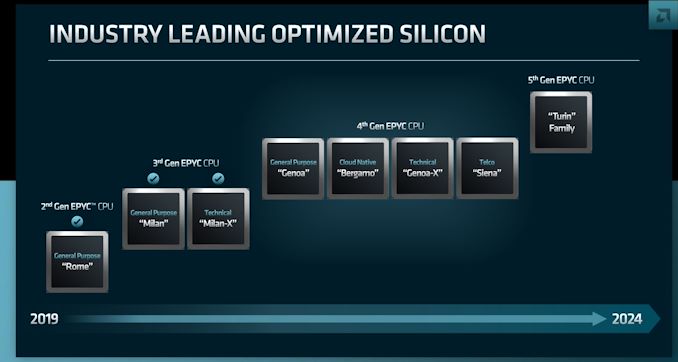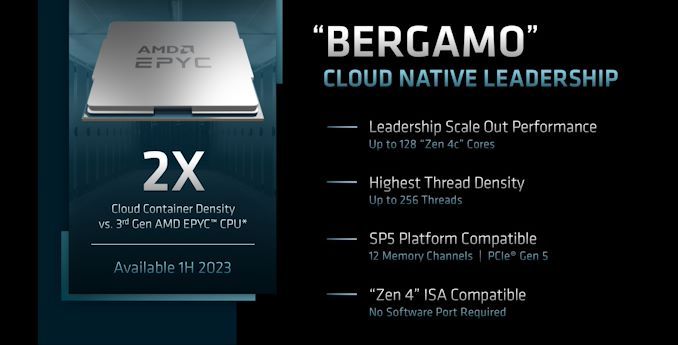AMD Updated EPYC Roadmap: 5th Gen EPYC "Turin" Announced, Coming by End of 2024
by Gavin Bonshor on June 9, 2022 5:00 PM EST
As part of AMD's Financial Analysts Day 2022, AMD has provided updates to its Server CPU roadmap going into 2024. The biggest announcement is that AMD is already planning for the (next) next-gen core for its successful EPYC family, the 5th generation EPYC series, which has been assigned the codenamed Turin. Some key announcements include various segmentations of its expected EPYC 7004 portfolio, including Genoa, Bergamo, Genoa-X, and Siena.
From the launch of AMD's EPYC 2nd generation products Codenamed Rome back in August 2019, the release of the updated EPYC 7003 processors, including both Milan and Milan-X, the next generation of EPYC 7004 codenamed Genoa is expected to launch in Q4 2022. Genoa will feature up to 96 Zen 4 cores based on TSMC's 5 nm process node, with the new SP5 platform bringing support for 12-channel memory, PCIe 5.0, and support for memory expansion with Compute Express Link (CXL).
While Genoa will benefit from up to 96 Zen 4 cores and will be released towards the end of the year in Q4, AMD also announced Bergamo, which will be available in the first half of 2023, with Genoa-X and Siena also being available sometime in 2023. AMD's Genoa-X will feature up to 96 Zen 4 cores based on TSMC's 5 nm manufacturing node, with up to 1 GB of L3 cache per socket. AMD Siena will be predominantly targeted as a lower-cost platform and will feature up to 64 Zen 4 cores, with an optimized performance per watt, making it more affordable for the Edge and Telco markets.
AMD Unveils 5th Gen EPYC (Turin)
Perhaps the most significant announcement on AMD's Server CPU Roadmap going into 2024 is the plan to bring its 5th generation of EPYC processors codenamed 'Turin' to market sometime before the end of 2024. As expected, AMD hasn't shed many details on the Turin family of processors, but we expect it to be named the EPYC 7005 platform to follow its current EPYC name scheme.
We know that the Zen 5 cores will be based on a 4 nm mode (likely TSMC but not confirmed) and a 3 nm version, as highlighted in AMD's CPU Core Roadmap through to 2024. AMD also states there will be three variants of the Zen 5 core in its CPU roadmap, including Zen 5, Zen 5 with 3D V-Cache, and Zen 5c.
From the latest roadmap highlighting AMD's EPYC products, we know that AMD's 5th generation of EPYC processors is expected to launch sometime before the end of 2024.











20 Comments
View All Comments
ballsystemlord - Thursday, June 9, 2022 - link
Unless I'm reading it wrong, Bergamo will have 4x SMP capability as opposed to 2x in our current CPUs. That's going to be interesting from a technical standpoint.Shorty_ - Thursday, June 9, 2022 - link
128C/256T, but also the ability to switch it into 128C/128T mode which if rumours are to believed, will outperform the 64C/128T 7763 by 60%. she's a monster.lemurbutton - Friday, June 10, 2022 - link
Monster for x86. Non-competitive vs Amazon Graviton3 in $/perf.AdrianBc - Friday, June 10, 2022 - link
You are probably right, but Amazon will not sell Graviton 3 to anyone.So this might be the best that small businesses or individuals will be able to buy in 2023.
Khanan - Friday, June 10, 2022 - link
Don’t believe and don’t feed a troll.gruffi - Monday, June 13, 2022 - link
Doubtful. Amazon claims that Graviton2 has 40% more perf/price compared to current competition. While Graviton3 offers 20-30% more perf/price than Graviton2. So, if Bergamo offers at least 70-80% more performance than Milan at the same price, which seems very much possible, it will be very competitive in terms of perf/price.mode_13h - Saturday, June 11, 2022 - link
At 128/256 cores/threads and 12 channels (probably up to 2 DIMMs/channel), does it make any sense even to support dual-CPU configurations? As long as you can scale up memory enough with a single CPU, that's going to be more power-efficient (not to mention more efficient, period).schujj07 - Wednesday, June 15, 2022 - link
Most servers are dual sockets. When you get into virtualization, having dual sockets is nice since you have more RAM slots available. In fact you are more likely to be RAM limited in your severs than CPU limited. Having a server with dual socket 32c/64t CPUs plus 1.5TB or 3TB RAM total would be VERY nice. Right now I am limited to 1TB/server.mode_13h - Thursday, June 16, 2022 - link
> Most servers are dual sockets.Not Xeon D, which was (at least initially) focused on power-efficient scalability. Reportedly, it was co-developed with Facebook.
The problem with dual-socket is that the cache coherency interconnect burns power and the latency of having to go through the other CPU has a big performance impact. While VM hypervisors and NUMA-aware scheduling and memory allocators can try to be clever about avoiding such scenarios, it's not a 100% solution. And to the extent that you can & are able to work around the problem, you might as well just sever the link and go single-CPU.
> In fact you are more likely to be RAM limited in your severs than CPU limited.
Perhaps CXL and memory tiering are better solutions to this problem. At least, it might scale better.
schujj07 - Thursday, June 16, 2022 - link
The most popular server type are dual socket. I cannot find the numbers at the moment but IIRC dual socket servers account for more than 50% of all servers. Depending on your applications it can be cheaper to go dual socket and not use LRDIMMS.